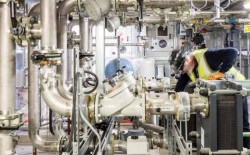John Charles, General Manager at NG Bailey Offsite Manufacture, explains how the company is embedding a net zero mindset into factory-based design and delivery.
At NG Bailey we have been pioneering offsite construction since the late 1990s, providing solutions to our clients in the public and private sector through our specialist production facility in Yorkshire, the largest of its kind in the UK.
Delivering improved environmental performance for our clients is one of our key values and putting offsite methods at the heart of our strategy has been instrumental in helping us to make positive progress in our Net Positive strategy. Offsite and modular methods of construction are increasingly being viewed as more environmentally efficient ways to construct buildings. Advancing the use of these methods in the industry is going to be key to achieving net zero goals at pace, both in our own work and those of our clients.
Making net zero possible at The Forge
The Forge, the first net zero office building in the UK, is an example of how offsite methods could be the future of low carbon construction. Working alongside multi-disciplinary design consultants, Bryden Wood, we developed, manufactured, and installed a mechanical and electrical (M&E) kit of parts. The development was the world's first large scale office building to be designed and constructed using a 'kit of parts' led solution, built on a platform design for manufacturing and an assembly approach.
Through early engagement, collaboration and exercises to ascertain value engineering opportunities, we identified products that could be assembled by operatives more efficiently in the factory environment. This also extended to our supply chain, with discussions ensuring that elements, such as ductwork and FCUs, worked with our lightweight bracket solution in the factory.
Prioritising early collaboration with stakeholders on a project like this is key to achieving positive outcomes. By designing out risk at the earliest opportunity and moving as many on-site processes to a factory setting as possible, the industry can realise the positive environmental benefits that are made possible by having decreased numbers of people on-site.
This is vital for firms increasingly looking at ways they can achieve their net zero targets. By manufacturing offsite, the local impact of a build is improved greatly, with less people travelling to site meaning reduced traffic levels and noise. It can also minimise the number of deliveries to site, all of which has a positive effect on environmental outcomes of a project.
At The Forge, the removal of 20,000 on-site labour hours delivered substantial carbon benefits by avoiding 35,600km of vehicle movements, which alone saved six tonnes of carbon from entering the atmosphere. This is the equivalent to the carbon dioxide removal from 276 tree seedlings grown for 10 years.
Low carbon construction
Putting lower carbon methods of construction into practice on projects has been a key part of our Net Positive strategy and wider net zero goals. We have committed to reducing our absolute Scope 1 and Scope 2 greenhouse gas emissions – which covers the emissions from sources we own and control directly, as well as those we cause indirectly – by 50% by 2031.
As well as putting in place a clear roadmap for reducing our own emissions, we are also well-placed to offer lower emissions solutions for our clients. Offsite construction has been a key part of being able to achieve this both in our own work and that of clients, providing ways to utilise less carbon intensive construction methods, use resources more efficiently and reduce wastage. With offsite construction accounting for less than 5% of the total construction market in the UK, there is still some way to go before we see widespread adoption of this modern method of construction. However, as net zero targets loom closer and companies look to how they can increase efficiency, offsite construction could offer the missing piece in the puzzle to achieving these goals.
SCIENCE-BASED CLIMATE CHANGE PLAN APPROVED
NG Bailey has become one of just ten UK construction and engineering companies to have a science-based target to tackle greenhouse gas emissions approved by the Science Based Targets initiative (SBTi). The UK's largest independent engineering and services business has had a 1.5°C near term and net zero commitment target approved.
NG Bailey has committed to reduce greenhouse gas emissions from sources it owns and controls directly, as well as those it causes indirectly, by 50% by 2031. It has also pledged to ensure 75% of its suppliers have science-based targets in place themselves by 2027. The SBTi is driving ambitious climate action in the private sector by enabling companies to set science-based emissions reduction targets.
Natalie Wilkinson (pictured), Head of Responsibility at NG Bailey said: "NG Bailey already has a long history of being a responsible business when it comes to sustainability, reducing our absolute emissions by 27% to date while setting out our longer-term ambitions in our Net Positive strategy.
"However, as one of the UK's leading M&E suppliers, we know we are at the forefront of being able to directly influence the transition to a lower carbon future. By taking the steps to have our science-based targets approved, we now not only have a clear roadmap for reducing our own emissions but can offer better lower emissions solutions for our clients, many of whom are on their own journeys. We know that the road ahead will be a long one, but by working together as an industry and committing to setting science-based targets, we are one step closer to making a net zero future possible."
For more information visit: www.ngbailey.com/who-we-are/our-responsibilities
Source: Offsite Magazine









